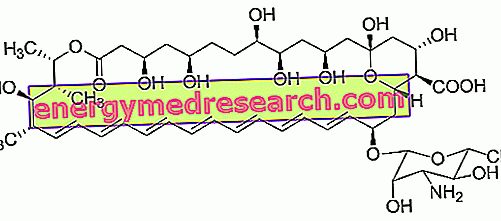Generality
Osteoncondrosis is a degenerative bone syndrome that fragments its extremities. Also known as osteochondritis, it occurs mainly at the level of the joints and afflicts above all young people, sportsmen and who, in general, is subject to continuous and repeated traumas.
There has been much debate about the causes of osteochondritis and it has been concluded that at the base there is a process of necrosis (tissue death).

What is osteochondrosis
The term osteochondrosis identifies a series of ossalungung or short pathologies, in which a small portion of extremity, bone or cartilaginous, detaches itself from the remaining healthy bone. In other words, a small terminal part of the bone is fragmented.
Osteochondrosis can afflict all the bones with an epiphysis or an apophysis, but it most affects those that make up a cartilaginous joint . In joint joints, the bone lesion separates a fragment composed of subchondral bone and adjacent cartilage (the term subchondral bone identifies the underlying bone layer of the cartilage). Thus a free osteocartilaginous body is formed . This fragment generates pain and is called by the medical term articular mouse .
The joint joints most affected by osteochondrosis are located at the level of:
- Knee.
- Hip.
- Astragalus.
- Elbow.
For years we discussed what determines this separation. Today, it appears that there is a process of necrotic degeneration at the origin. Necrosis is the death of the cell. It first causes the weakening and then the fragmentation of the affected bone portion.
The osteocartilaginous lesion follows a slow course, characterized by 4 stages. In the first two stages, the lesions are considered stable and the prognosis is good. In the third and fourth stages, on the other hand, the lesions have become unstable and the prognosis is not favorable. The distinctive features of the 4 stages are summarized as follows:
- Stage 1. Small flattening of the bone at the site of injury.
- Stage 2. The fragment begins to stand out. A small rhyme is appreciated below it.
- Stage 3. The rhyme becomes more marked. The fragment is almost completely detached.
- Stage 4. The osteocartilaginous fragment is detached from the remaining bone and is "free" in the joint.
Epidemiology
Osteochondrosis affects male sex the most and its incidence in the general population is 1.7%. It is a pathology typical of the developmental age (first and second decade of life), due to the intense activity of ossification. Usually, in these cases, the problem resolves spontaneously at the end of skeletal maturity.
When osteochondrosis occurs in adults, such individuals often practice sports or are engaged in heavy work activities. This explains, in part, why men are more affected.
Causes
Necrosis of an epiphysis or a bone apophysis is the main cause of osteochondrosis. It arises following a blood flow interruption. In fact, it is an avascular necrosis . The factors that determine the occlusion of the vessels are:
- ischemia.
- Trauma or more repetitive traumas due to:
- Sport activity.
- Heavy work activity.
- Intense ossification, typical of the developmental age.
- Genetic predisposition.
- Endocrine factors.
Very often these factors act in concert. For example, osteochondrosis in young athletes is very common.
Symptoms
To learn more: Symptoms Osteochondrosis
The main symptoms of osteochondrosis are:
- Pain in the affected joint.
- Swelling.
- Articular effusion (or hydrartre).
- Progressive joint blockage.
At the beginning, this symptomatology is tolerable. In fact, osteochondrosis follows a very slow course: when it occurs, pain is of low intensity and intermittent duration; likewise, joint functions are only partially prevented. From the anatomo-pathological point of view, it is the moment in which the future ostecartilaginei fragments begin to emerge.
The deterioration takes months, in some cases even years. In this period of time, the osteocartilegine fragments become real free bodies within the joint. The pain, therefore, becomes more intense and continuous. Joint blocking greatly reduces joint motility. The hydrartre is remarkable.
Diagnosis
Important, as in all diseases, is early diagnosis. This makes it possible to intervene in a non-invasive manner and to stop the evolution of bone lesions.
The analysis of joint motility is the first possible diagnostic test: the suspicion arises if the angle of extension of a joint is reduced compared to normal.
The fundamental instrumental examination, which shows at what stage osteochondrosis has come, is magnetic resonance . It shows the extent of the lesion and allows, therefore, to plan an effective therapy. Another advantage: it is not invasive.
The other diagnostic tests are:
- Radiography.
- Bone Ultrasound.
- Computerized axial tomography (TAC).
Radiography . It shows the formation of the osteocartilaginous fragment and, in more advanced cases, free bodies, or articular mice. This is a moderately invasive test (involves exposure to ionizing radiation).
Bone Ultrasound . Provides useful information on bone health. Negative feedback indicates that the bone is at risk of fragmentation. It is not invasive.
Computerized axial tomography . Shows the magnitude and precise site where bone fragmentation occurred. Disadvantage: it is an invasive technique (involves exposure to ionizing radiation).
Therapy
The stage of the lesion is fundamental for setting up the therapy.
It can be:
- Conservative.
- Surgical.
- Pharmacological.
Conservative therapy is more likely to succeed when the lesion is stable (stage 1 and stage 2). Consists of:
- Rest from physical activity / work (if intense) for 6-8 weeks.
- Physiotherapy.
- Immobilization with plaster; use of crutches (if a lower limb is hit).
Conservative therapy is also adopted for the forms of osteochondrosis of young age. These tend to heal spontaneously, but sometimes a supportive therapeutic treatment is needed.
Surgical therapy is reserved for unstable stadiums, or for stable ones that have not benefited from conservative treatment. It consists of an intervention in arthroscopy . The purpose is to:
- Recover the fragment, if it was not yet completely detached (stage 3). To do this, micro-perforations are practiced in the affected portion, in order to favor vascularization.
- Remove the detached fragments from the healthy bone (stage 4). The affected bone end is reconstructed and the cartilaginous component is reconstituted, by means of a chondrocyte transplant. Chondrocytes are the cells that produce cartilage.
Drug therapy is useful for alleviating the sensation of pain and must be associated with two therapies. In fact, it is not enough alone. It is based on the administration of:
- Analgesics.
- Non-steroidal anti-inflammatory drugs (NSAIDs).
Complications
Possible post-operative complications are:
- Chronic pain.
- Reduced function of the affected joint.
- Osteoarthritis.
Prognosis
The prognosis depends on several factors, such as:
- Age of the patient.
- Cause.
- Affected joint and degree of injury at the time of diagnosis.
- If a conservative therapy has been implemented in the presence of osteochondritis at stages 3 and 4.
The forms of osteochondrosis of young age tend to resolve spontaneously. The prognosis is therefore good.
If at the beginning there is a trauma and the diagnosis is late, the prognosis becomes worse. The recovery, in fact, is very slow and the surgical operation, as we have seen, has its complications.



